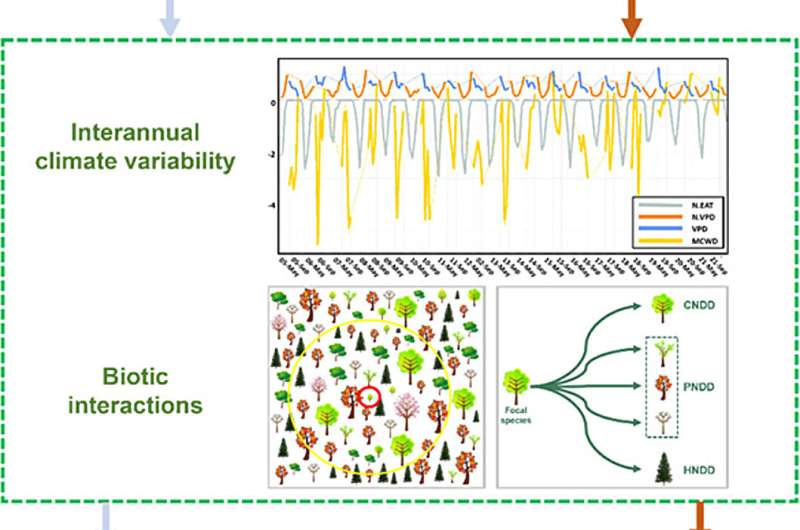This article has been reviewed according to Science X's editorial process and policies. Editors have highlighted the following attributes while ensuring the content's credibility:
fact-checked
peer-reviewed publication
trusted source
proofread
How inter-annual climate variability affects seedling survival in temperate forests

Two new studies by researchers from the Institute of Applied Ecology of the Chinese Academy of Sciences have revealed the relative effects of interannual climate variability and density-dependent species interactions on seedling survival in temperate forests.
The studies, published in Ecology and Fundamental Research, use 15 years of data from more than 53,000 seedlings in the Changbai Mountain forest in northeast China.
The researchers found that interannual climate variability, which refers to the changes in temperature, precipitation, snowpack, and ultraviolet radiation from year to year, had the strongest effect on seedling survival at the community level, compared with other factors such as biotic interactions and habitat conditions.
They also discovered that climate variability can modify the effects of biotic interactions, such as the negative effects of having too many neighbors of the same species (known as conspecific negative density dependence, or CNDD). For example, higher snowpack and warmer temperatures during the growing season reduced the CNDD effect, while higher ultraviolet radiation and rainfall increased it.
In addition, the researchers found that the effects of climate variability and biotic interactions varied depending on the plant traits of the seedlings, such as their dispersal mode, specific root length, specific leaf area, and leaf dry matter content. These traits reflect the strategies that plants use to acquire or conserve resources, such as water, nutrients, and light.
The researchers found that seedlings with resource-acquisitive traits, such as longer roots and larger leaves, had lower survival rates, which suffered more from CNDD and extreme temperatures. Seedlings with resource-conservative traits, such as higher leaf dry matter content, had higher survival rates, were more resistant to drought and cold better, and experienced fewer negative interactions with other species.
The researchers concluded that interannual climate variability plays a dominant role in seedling survival in temperate forests, and that functional traits mediate seedling responses to climate and biotic interactions.
They also suggested that climate variability should be considered in future studies of forest dynamics and biodiversity, as it may act as an inhibitor or accelerator of density-dependent interactions, which are key processes for species coexistence and community diversity.
More information: Zhichao Xu et al, Interannual climate variability has predominant effects on seedling survival in a temperate forest, Ecology (2022). DOI: 10.1002/ecy.3643
Zhichao Xu et al, Functional traits mediate seedling survival response to climate in a temperate forest, Fundamental Research (2023). DOI: 10.1016/j.fmre.2023.12.002
Journal information: Ecology
Provided by Chinese Academy of Sciences


















